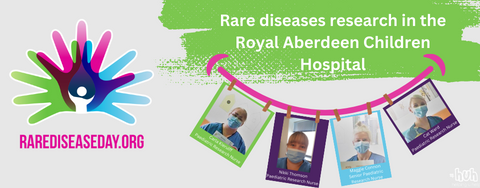Rare Disease Day 28th February
Rare Disease day is an opportunity to raise the awareness for people living with a Rare Disease. Some 300 million people worldwide are affected with a rare disease. More information about Rare Disease Day is available on their website https://www.rarediseaseday.org/
To mark this day we are highlighting research on rare diseases carried out in Aberdeen.
The TrustTSC study
The TrustTSC study is for children with tuberous sclerosis complex (TSC) associated epilepsy. TSC is a rare genetic disease which affects about 1 in 6000 people. It causes the development of non-cancerous tumours in different parts of the body. It can affect the brain and cause epilepsy (a condition that causes seizures). [1]
Patients receive the study medicine or placebo along with their normal epilepsy medicine. The purpose is to find out if the new medicine is safe and can reduce the number of seizures compared to the placebo. A placebo looks like the study medicine but does not contain any active medicine. The study takes place in about 60 centres worldwide. This study is organised and paid for by, Marinus Pharmaceuticals, Inc., a pharmaceutical company based in the U.S.A.
CSF SMA study
Spinal Muscular Atrophy (SMA) is a genetic disorder that occurs in 1 out of 10,000 live births [2]. It is a childhood motor neuron disease. It targets the nerve cells (motor neurons) found in the spinal cord. Motor neurons are the key link between the brain (where we plan and decide on movements) and the muscles (which produce the movements). Affected children lose or do not develop basic muscle control. If untreated, most children will not survive to their 3rd birthday.
Our researchers have pioneered research showing that SMA also affects other body systems including the blood vessels. Blood vessels are important in the spinal cord where they form a barrier, controlling what can enter and exit spinal cord. The researchers think that this barrier might be leaky and could further harm spinal cord motor neurons.
In this study the researchers will test this theory. They will analyse the fluid that surrounds the spinal cord of patients with SMA living in the Grampian region. When patients receive treatment in the hospital a small amount of this fluid needs to be removed. This fluid is currently disposed of, but the researchers would like to use it to test their theory. Donation of spinal fluid is voluntary and there are no additional procedures for patients.
1 Tuberous sclerosis - NHS (www.nhs.uk)
2 Spinal Muscular Atrophy - National Organization for Rare Disorders (rarediseases.org)
